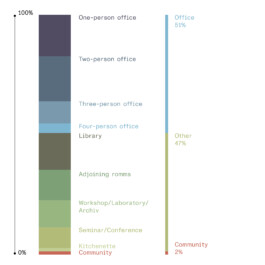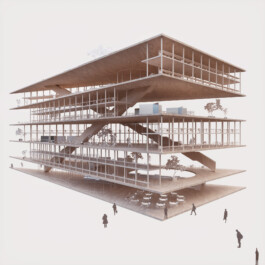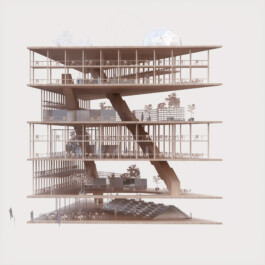HAUS FÜR NEUES GEISTESWISSENSCHAFTLICHES ARBEITEN
Location: Berlin
Status: Initiative
Partner: Geisteswissenschaftliche Zentren Berlin e.V. (GWZ)
Year: 2021-
Program: Office, Mixed Use
Role: Initiative, Development, Design
Team: Hans von Bülow, Julian Meisen, Cornelius Voss

What effects can new work have on scientific research within the humanities? Together with Geisteswissenschaftliche Zentren Berlin e.V., an association of Berlin-based research institutes located in the field of humanities, we are initiating the development of a unique building type: A space where new work concepts are synthesized with the specific demands of scientific research in order to optimize and update the work environments of a number of Berlin based research institutions, which are currently suffering from exploding rents and outdated work environments. Rather than just an architectural design, we conceived a holistic development concept, including spatial ideas, programmatic concepts, and organizational and financial structures.


A one-person office used by GWZ Berlin e.V.
The analysis of GWZ Berlin e.V.'s current spaces identifies the lack of community spaces





Since work in the humanities requires calm and concentration, our concept does only partially adopt typical new work environments. In addition, the individual office – an unpopular typology within the new work discourse – is not fundamentally questioned but updated in reference to the concept of the studiolo, a medieval typology for room cells for research and contemplation. The proposed concept envisions a building subdivided into large double-height storeys, in which two-level-structures of monastic room cells are juxtaposed with spacious and open workspaces.

The painting "Saint Jerome in his study" by Antonello da Messina was created in the second half of the 15th century and depicts the renaissance concept of a studiolo. © The National Gallery, London




Haus für neues geisteswissenschaftliches Arbeiten is still an idea without a location. To best illustrate its concept, the project is visualized on a vacant lot at the southern edge of Berlin’s Kulturforum in proximity to several culture and science institutions. The project is conceived within the legal framework of a foundation, which has to be to set up and controlled by the involved parties of the public sector. It is dependent on a long-term leasehold of a publicly owned property.


HAUS FÜR NEUES GEISTESWISSENSCHAFTLICHES ARBEITEN
Location: Berlin
Status: Initiative
Partner: Geisteswissenschaftliche Zentren Berlin e.V. (GWZ)
Year: 2021-
Program: Office, Mixed Use
Role: Initiative, Development, Design
Team: Hans von Bülow, Julian Meisen, Cornelius Voss
What effects can new work have on scientific research within the humanities? Together with Geisteswissenschaftliche Zentren Berlin e.V., an association of Berlin-based research institutes located in the field of humanities, we are initiating the development of a unique building type: A space where new work concepts are synthesized with the specific demands of scientific research in order to optimize and update the work environments of a number of Berlin based research institutions, which are currently suffering from exploding rents and outdated work environments. Rather than just an architectural design, we conceived a holistic development concept, including spatial ideas, programmatic concepts, and organizational and financial structures.

A one-person office used by GWZ Berlin e.V.

The analysis of GWZ Berlin e.V.'s current spaces identifies the lack of community spaces





Since work in the humanities requires calm and concentration, our concept does only partially adopt typical new work environments. In addition, the individual office – an unpopular typology within the new work discourse – is not fundamentally questioned but updated in reference to the concept of the studiolo, a medieval typology for room cells for research and contemplation. The proposed concept envisions a building subdivided into large double-height storeys, in which two-level-structures of monastic room cells are juxtaposed with spacious and open workspaces.

The painting "Saint Jerome in his study" by Antonello da Messina was created in the second half of the 15th century and depicts the renaissance concept of a studiolo. © The National Gallery, London




Haus für neues geisteswissenschaftliches Arbeiten is still an idea without a location. To best illustrate its concept, the project is visualized on a vacant lot at the southern edge of Berlin’s Kulturforum in proximity to several culture and science institutions. The project is conceived within the legal framework of a foundation, which has to be to set up and controlled by the involved parties of the public sector. It is dependent on a long-term leasehold of a publicly owned property.
